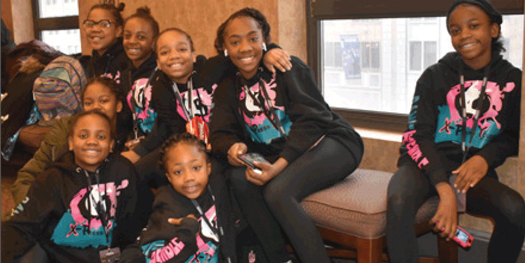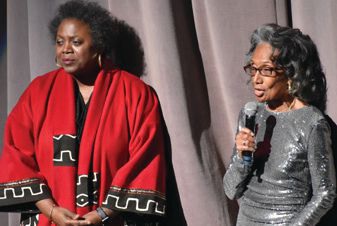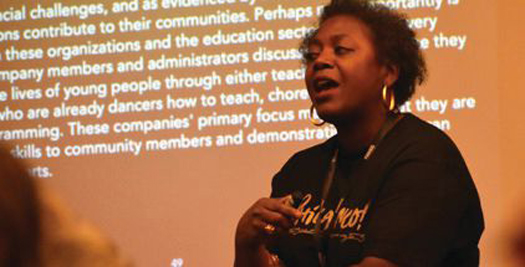Conference and festival highlighting Blacks in Dance celebrated in Philly
By Michael Z. Muhammad -Contributing Writer- | Last updated: Feb 5, 2020 - 9:58:01 AMWhat's your opinion on this article?

Philadelphia creative and performing arts youth group X-Press Yourself.
|
If you ever wondered what the power of Black organization looks like, you need to look no further than this group. Their model may be the best-kept secret in America.
Philadelphia area dance instructor and past board member Arthur Leo Taylor shared the history of the conference and festival with The Final Call.
In 1988 at the invitation of Joan Myers Brown, founder of Philadelphia’s world-renown dance company Philadanco, four high powered Black women met at her kitchen table to talk shop. Ann Williams of Dallas Black Dance, Cleo Parker Robinson from Denver, Lula Washington of the Lula Washington Dance Theater in Los Angeles and Jeraldyne Blunden of the Dayton Contemporary Dance Company.
“They put their egos aside and found they had lots in common. By pulling their resources together they realized they could make more happen in the Black world of dance, and the IABD was given birth, and here we are 32 years later,” explained Mr. Taylor.
What took place in Philadelphia during this year’s conference held Jan. 14-19 was spectacular as the greatest minds and dance companies in the world converged on the “City of Brotherly Love and Sisterly Affection.”
Coming from as far away as Australia was Carole Johnson, an incredible dance legend who trained at Julliard in 1963. She went on to found the Bangarra Dance Theater, where her work with the aboriginal population is legendary.

Denise Saunders Thompson and Joan Myers Brown, founder of Philadanco, on stage at the Merriam Theater in Philadelphia.
|
“This conference brings together the Black dance sector in ways that we normally wouldn’t be able to work together or celebrate one another,” she said. “This is about us being able to talk about challenges and celebrate the work that is being done in the community. There is networking, panel discussions, auditions, and performances,” added Ms. Saunders Thompson. She didn’t even scratch the surface.
Ms. Saunders Thompson said the model used for the gathering and festival is “multilayered and complex.” “We have showcases where we are bringing companies from around the world in a performance opportunity over a four to five-day time period. We are working with dancers and instructors in master’s classes who have knowledge and style in technique and different genres of dance to share that here. Folks can come and learn and be educated more about their history and contributions Blacks have made in dance,” she said.
Imagine being able to witness performances by Philadanco, The Alvin Ailey American Dance Theater, the Dayton Contemporary Dance Company, the Dance Theatre of Harlem, Dallas Black Dance Theatre all on the same bill. Well, that’s precisely what happened during the theater performance on Saturday night during the conference. Added as a further sweetener were the Lula Washington Dance Theatre, Cleo Parker Robinson Dance Ensemble, and more.
Of note was a performance given Jan. 17 by Chicago’s Deeply Rooted Dance Theater entitled “Until Lambs become Lions.” Performed to the music of Nina Simone’s famed “Isn’t it a Pity,” it brought the house down with a raucous standing ovation. The performance portion of the conference was held over four days and broken into segments.
“This conference is important because it allows people of color to share all the joy as well as the suffering but most important to learn how we can go forward from where we are now,” Dr. Brenda Dixion-Gottschild, a noted scholar and professor emeritus of dance studies at Temple University, told The Final Call following a wokshop she facilitated entitled “Collective Strategies for Disaporan Women in Dance.”

Dr. Brenda Dixon-Gottschild moderating workshop called, “Collective Strategies for Disaporan Women in Dance.”
|
During the conference, 49 youthful Black ballerinas were able to audition for the top ballerina companies in the country. Four additional auditions were held for younger students, men, and modern dancers. Historically, opportunities are scarce for Black ballerinas.
The inclusion of youth into the conference was significant, noted Dr. Dixon-Gottschild, as she stated it was like taking them to church. “A conference like this provides moral, ethical, and spiritual teachings to the people who are here. We teach the good,” she said.
“Here we can engage our youth in the traditions of the ancestors. They learn about all of the greats that came before, like Katherine Dunham. They come to realize whose shoulders they are standing on. So, these students must understand they come from greatness,” added Mr. Taylor.
Joyce Stokes from the Washington, D.C.-based Jones Hayward Dance School brought 15 students to the conference. We are one of the oldest dance schools in Washington, she said.
“It is important that our students be exposed to this type of conference. We feel that dance is a discipline for life. We have been around since the ‘40s, and we want our legacy to continue. We want to make sure our children have all of the confidence and discipline that they need to succeed in life. Not just in the dance world, and that is what this conference instills,” said Ms. Stokes.
“Today we were involved in master classes and panel discussions by dance legends. They have been exposed to college and how that would affect career paths. The children were exposed to all different types of dance: ballet, modern, jazz, tap, African, and Hip Hop. I would like to see my students walk away with a sense of history, with more confidence to succeed not just in dance but in life period. Having a sense of self-discipline that they can do whatever they put their minds to, but it takes arduous work,” she continued.
Leander Gray, a 16 year old and member of the Washington, D.C.-based Duke Ellington School of the Arts, told The Final Call this was his first time at the conference, and it proved to be an eye-opener.
“I will leave here with the drive to put more work into what I do. I now realize to get there, you have to have a work ethic and strive for the best,” he said.
As for the future, board president Denise Saunders Thompson stated, the priority for the International Conference and Festival of Blacks in Dance is funding and visibility. “Our greatest challenge is funding. Getting the message out about what we are doing. Being well-resourced enough to get our message out and gaining the support of the Black community,” she said.
For more information about the International Conference and Festival of Blacks in Dance visit www.iabdassociation.org.
INSIDE STORIES AND REVIEWS
-
-
About Harriett ... and the Negro Hollywood Road Show
By Rabiah Muhammad, Guest Columnist » Full Story -
Skepticism greets Jay-Z, NFL talk of inspiring change
By Bryan 18X Crawford and Richard B. Muhammad The Final Call Newspaper @TheFinalCall » Full Story -
The painful problem of Black girls and suicide
By Charlene Muhammad -National Correspondent- » Full Story -
Exploitation of Innocence - Report: Perceptions, policies hurting Black girls
By Charlene Muhammad -National Correspondent- » Full Story -
Big Ballin: Big ideas fuel a father’s Big Baller Brand and brash business sense
By Bryan Crawford -Contributing Writer- » Full Story






 Click Here Stay Connected!
Click Here Stay Connected!








